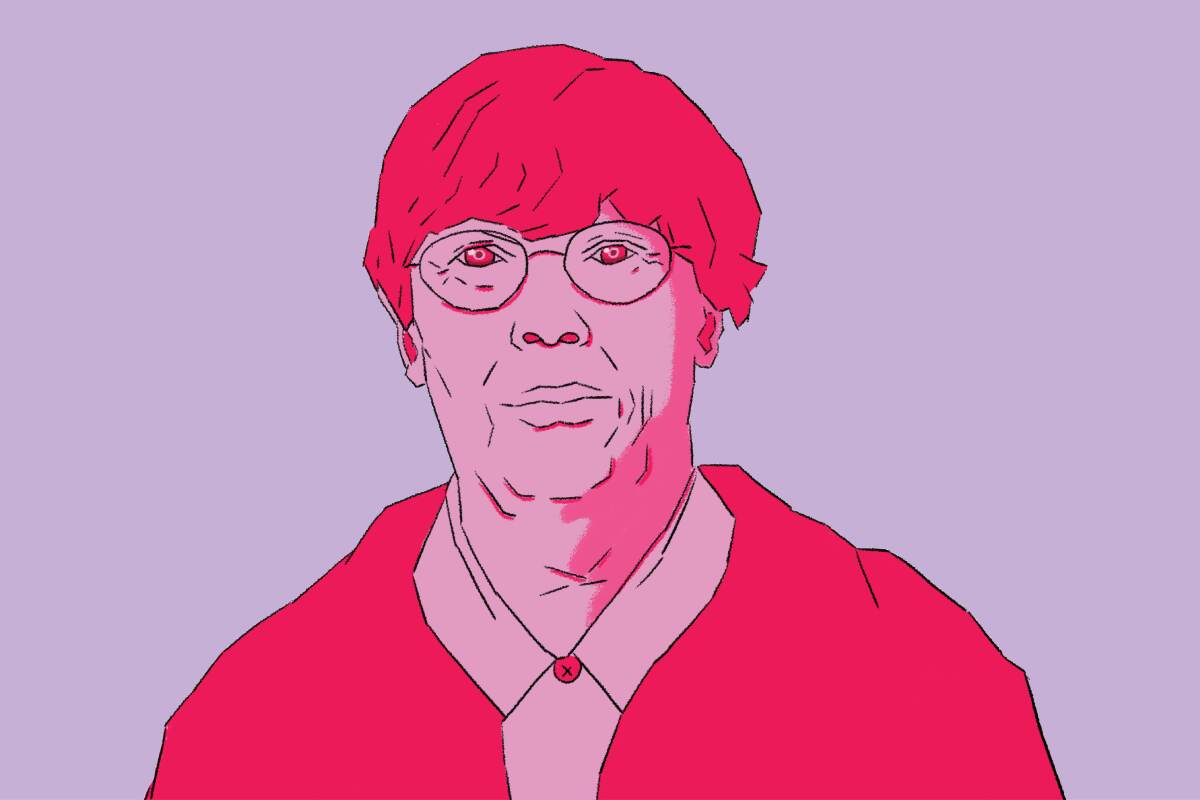How gay feminist composer Pauline Oliveros taught us to hear with more than ears

On each of the four Saturdays in April, people from around the world — music people, nonmusic people, critics trying to make ourselves useful — participated in an online Pauline Oliveros “sonic meditation.” We listened for silence. We waited for sounds and then sounded. We responded to our body weight, to technology, to what others were responding to.
“Express a dream,” Oliveros asked of her performers when she first created her sonic meditations in the 1980s. Now, four years after her death at age 84, it seems like she might have known what was coming, the novel coronavirus making all of us dreamers.
For the record:
10:56 a.m. Oct. 2, 2020An earlier version is this article misstated the title of an opera. The correct title is “The Nubian Word for Flowers,” not “The Nubian World.”
The composer spent much of her life as a crusading outlier. She was a pioneering woman in electronic music, a pioneering improviser, a pioneering accordion player, a pioneering feminist, a pioneering gay woman coming out when that was daring.
She was a lifelong culture warrior who kept her wit and her welcoming spirit throughout it all. An inveterate punster, she once fulfilled a saxophone commission with “Saxual Orientation.” With Oliveros, we were all invited to the party.
In 1974, she gave us, in collaboration with Fluxus artist Alison Knowles, the droll performance piece “Beethoven Was a Lesbian.” It was a reaction not to Beethoven’s music, which Oliveros loved, but to Beethoven as symbol of the Great Artist, a controversial issue that couldn’t be timelier today in our reconsiderations of white-male-dominated Western music. Yet, in Oliveros’ own way, her reigning vision, brilliantly expressed through sound, was of social and spiritual Beethovenian betterment.
Her means and her person, of course, were entirely different, as can be seen in “The Well & The Gentle,” which comes across as a kind of self-portrait. These two pieces from the early 1980s, which can be performed individually or together, are group improvisations based on specific actions.
“The Well” asks performers in a small ensemble (any instrumentation will do) to dig deep into the well of their own being. The score supplies a scale of seven pitches between C and A. Underneath that is a five-pointed star with the words at each point, beginning at the top and moving clockwise: Listen, Soar, Support, Match, Merge.
Oliveros happened to like wells and cisterns a lot and the incredible reverberations she could achieve in them with richly textured drones. They inspired her to adopt a practice she called “deep listening.”
Deep listening does not prize the ear alone. When Oliveros became the first music director of the tape music studio at Mills College in 1966, she insisted that the facility be made available to the community. She wanted people to have access to what was still the male-centric, tech-nerdy, elitist world of electronic music. I once told Oliveros that I was nothing like her, but that the year after she left Mills to head a new electronic music center at UC San Diego, I used to skip my required morning ear training classes at UC Berkeley to fool around with the synthesizer at Mills instead. She was delighted. Ear training is nonsense, she said. You can’t train the ear. It can only hear. The brain listens.
One revelation of Oliveros’ great resonances is that the whole body listens. She wrote pieces in which she asked the performer to listen to her feet as they padded along the ground. In the cisterns she so loved, sound has such a physical presence that it feels like it is coming at you through the pores of your skin; it doesn’t get to the brain until it has worked its way up your bloodstream. You listen through your lungs. You listen through your stomach. You listen through your heart.
And you come to understand that you also listen to your body, which is its own percussion instrument. “The Well” is the reverberator for whatever is going to happen.
Coronavirus may have silenced our symphony halls, taking away the essential communal experience of the concert as we know it, but The Times invites you to join us on a different kind of shared journey: a new series on listening.
“The Gentle” is different. It uses a rhythmic pattern that Beethoven might have come up with for his seventh, supposedly “Apotheosis of the Dance,” symphony. Again, Oliveros supplies a seven-note pitch mode, but this time, players create one- to three-note patterns based on the rhythm, which serves as a firm but gentle foundation. You could say the same about Oliveros, although she wasn’t always perceived that way.
She could seem formidable; she could take care of herself. She needed to. To her great dismay, for instance, a noted reference work once identified her as a member of SCUM (Society for Cutting Up Men), which she wasn’t. Still, when she took up karate, it was for her a spiritual practice akin to deep listening.
There are a million ways to perform these pieces. They need to be fashioned for the specific players, the physical site, the occasion. For Oliveros, how you listen was intricately tied to where you listen, when you listen, with whom you listen, why you listen and what you can then do with what you listen to.
The International Contemporary Ensemble performed a sonic meditation, based largely on “The Well & The Gentle,” one glorious morning at the Ojai Music Festival that remains a treasure on the festival website. Music and matter intertwine, and it is through a gentleness of sounding and morning sun that there is a sublime merging.
Merging is how Oliveros became Oliveros. In the early 1960s, she had studied at San Francisco State, where she met many like-minded composers. Together they founded the San Francisco Tape Music Center. Coincidentally, the subject of this series last week, “Sinfonia” composer Luciano Berio, was then teaching at Mills and played for them his revolutionary Italian tape pieces.
But the Bay Area composers went their own way with their funky equipment. They relished improvisation and invented their own free-form music. They caught the attention of, and merged (that Oliverosian word again) with, the pop scene. Terry Riley’s “In C” had its premiere at the Tape Music Center; Oliveros played accordion.
Listening is the act of attending your time and place, and Oliveros was one of the great listeners. That helps to explain how she developed a second sense for always being in the right place at the right time.
That was certainly so in L.A. She led from her accordion unforgettable sonic meditations at the Woman’s Building, the downtown feminist arts center in the 1970s and 1980s. In an early event by the new opera company the Industry, Yuval Sharon produced a preview of her opera, “The Nubian Word for Flowers,” with texts by Oliveros’ wife, the Black writer and artist Ione, a stunning work that deconstructs colonialism through a British field marshal discovering rapture on a Nubian island.
That would turn out to be Oliveros’ last major project. But she had the gratification at the end of her life to have found in the International Contemporary Ensemble’s flutist, Claire Chase, her most persuasive and influential advocate. Chase was to have led a season-long investigation of Oliveros for the Los Angeles Philharmonic this coming season. Whether any of that can be salvaged remains to be seen and heard. But if any composer can be adapted to another time and place it is Oliveros. Chase, who copresented “World Wide Tuning Meditation” with Ione, already proved that practically the minute we went into lockdown.
Starting points
An exceptional recording of “The Well & The Gentle” with Oliveros and Relache, the Philadelphia new music ensemble she wrote it for, came out as a two-LP set in 1984 on hatART. It has never been transferred to CD or digital, but a kind soul has uploaded it to YouTube. Alternative performances can be found on Vimeo and Soundcloud.
An engrossing introduction to Oliveros can be found on Nadia Sirota’s podcast, “Meet the Composer,” which includes a performance, recorded in binaural sound, of “Tuning Meditation” that is far lovelier than what the April event I mentioned could accomplish on Zoom.
With live concerts largely on hold, critic Mark Swed is suggesting a different piece of recorded music by a different composer every Wednesday. You can find the series archive at latimes.com/howtolisten and support Mark’s work with a digital subscription.
More to Read
The biggest entertainment stories
Get our big stories about Hollywood, film, television, music, arts, culture and more right in your inbox as soon as they publish.
You may occasionally receive promotional content from the Los Angeles Times.








